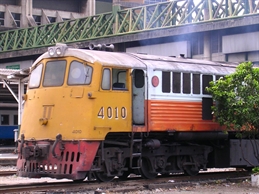
Senior Thai government officials have outlined the scope of Thailand’s ambitious rail programme as the Southeast Asian country moves to position its self as a regional hub.
To achieve this, the government’s approach is a multi-pronged one under a master plan for the railways, said Arkhom Termpittayapaisith, deputy transport minister and secretary general of the government’s strategic think tank, the National Economic and Social Development Board, during an interview carried on the government website.
Termpittayapaisith spoke of three steps: short term initiatives that will make the current antiquated system work better, followed by a move to standard gauge rails and, finally, high speed trains, which are still some way off.
In the short term, the government’s focus is on improving connectivity to northeastern Thailand by removing obstacles. There are 2,000 roads crossing the rails, Termpittayapaisith said, adding that “we will eliminate all of them from year to year.”
Behind this is a plan to implement standard gauge rails. “[We will] introduce the new system, standard gauge, which is wider than the one metre which we have right now,” Termpittayapaisith said.
Backing for this comes from another key government source, minister of finance Sommai Phasee. “We are going to adopt the dual track based on the standard 1.435 metres,” he told a meeting of the Foreign Correspondent’s Club attended by Asia Cargo News.
This, though, is a big change. As Termpittayapaisith went on to say, standard gauge would give the railways more capacity and more speed. Thailand is putting itself in the position of being able to move volumes: more of them and more easily.
One prompt here is Thailand’s own economic needs. A lot of goods in Thailand are already moved by fleets of trucks. It works – just – because oil prices are low, but real efficiencies, savings and growth come from infrastructure such as railways designed to move larger volumes. “We need to move all our goods from the road to the rail. This is transforming,” Termpittayapaisith said.
But this is not just about Thailand; it is also about ASEAN (the Association of South East Asian Nations) and beyond.
Already, a partnership with China is expected to help develop Thailand’s poorer Northeast, by linking the capital Bangkok with Nong Khai as well as leading to onward connections to Laos and southern China.
“That will open Thailand as a gateway to ASEAN. That’s our focus,” Termpittayapaisith said.
(Later in the interview he went on to add “We have been discussing with [Greater Mekong Subregion, or GMS] countries how to build our rail network together.” The GMS is a sub-ASEAN group bringing together Thailand, Cambodia, Laos, Myanmar, Vietnam and the China’s Yunnan province and Guangxi Zhuang Autonomous Region. What is being seen in Thailand could be the start of a broader move to build railways in this part of the world.)
Japan, though, is still very much in what is a very open game when it comes to Bangkok’s plan to build an east-west corridor across northern Thailand, the current plan for which is to connect Mae Sot on the eastern border with Myanmar to Mukdahan on the western border with Laos.
“It can be one metre or it can be the standard gauge,” said Termpittayapaisith.
He went on to point out that there are possibilities for expansion on either side of Thailand. To the west, expansion would allow better access to Myanmar and India, and to Laos and Vietnam on the east.
This is to be on top of an already much-talked about and planned southern east-west corridor, which looks likely to start in Dawei, Myanmar, cross Thailand and continue into Cambodia and southern Vietnam. The Myanmar-Thailand section is likely to draw heavily on Japanese funding.
Here two very senior figures, finance minister Phasee and prime minister Prayuth Chan-ocha, have put down markers.
“It would be very good to have a big port there,” Phasee said, while noting that it will also be necessary to build up highways and railways to the proposed Dawei port and industrial complex.
There is, though, some informed skepticism about this plan. It will be a costly venture building both, and some doubt if the traffic warrants it, as road volumes are already low.
By Michael Mackey
Southeast Asia Correspondent | Bangkok



